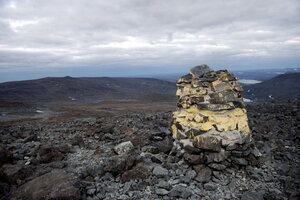A Norway gift that would move mountains
To honor Finland’s independence anniversary, Norway may give it a mountain peak along their border. The gift, while a small gesture, symbolizes a kind of peace that may keep land-grabbing bully nations at bay.

A view of Halti mountain, on the Finnish and Norwegian borders, in Enontekio, Finland. Norwegian Prime Minister Erna Solberg is considering moving the border to give the mountain's peak as a gift to Finland when the Nordic country next year celebrates 100 years of independence from Russia.
Mikko Stig/Lehtikuva, via AP, File
Norway is considering an unusual gift to Finland to honor its neighbor’s 100th anniversary of independence: a mountain peak. Yes, Norway might move its border next year so that Finland can have the highest point on Halti mountain. The proposal would be only a small gesture, a mere 66-foot difference on a desolate landscape. Yet in a world still fearful of big nations taking territory by force, the transfer would show by example how trust and cooperation between countries can lead to even a gift of territory.
Much of the fear in foreign affairs today centers on recent land grabs by two large nations, China and Russia. China has occupied Philippine islets and claims other islands far from its shores. US Defense Secretary Ash Carter says many Beijing leaders believe “it’s now China’s time to dominate its region.” Russia, meanwhile, annexed Ukraine’s Crimea in 2014 and has made threatening moves against the Baltic states.
Such bullying tactics hark back to the days when powerful countries believed they must dominate their neighbors. Yet the idea of regional hegemons, or “core states,” could be fading as more countries band together in groupings for peaceful purposes. The European Union helped Germany overcome its early-20th-century aggressive behavior. Various pacts in the Western Hemisphere restrain the United States from throwing its weight around. Indonesia is constrained by the Association of Southeast Asian Nations. India’s regional ambitions are kept in check by its fellow South Asian nations.
One region very much locked in a violent struggle between big powers is the Middle East. Iran and Saudi Arabia, while not at war over their own territories, are fighting by proxies in Syria, Iraq, Lebanon, and Yemen. Many experts hope the nuclear deal signed by Iran in 2015 will mark a new beginning for Iran to reduce its regional aggression against its Arab neighbors (and, one can hope, Israel).
An excellent example for regional cooperation is the Nordic Council, which was established in 1952 and includes the five Nordic countries – Finland, Sweden, Norway, Denmark, and Iceland. In a White House meeting with leaders of those countries in May, President Obama noted, “In their own region and with the world, the Nordic countries are a model of cooperation, and they consistently punch above their weight in meeting the challenges of our time.”
The Nordic success could also serve as a model way to resolve current negotiations between eight countries with coastlines along an Arctic Ocean that is losing its ice cap, opening routes for ships and a race for resources. The Arctic Council was formed in 1996 and includes the five Nordic states as well as Russia, Canada, and the US.
Such bodies help create the rules for peace and reduce fear of regional bullies. “At times when basic rules and norms of international standards are contested, [the Nordic Council members] stand side by side to defend them,” says Prime Minister Stefan Löfven of Sweden.
A gift of land by Norway to Finland would be a small but powerful reminder of how friendship can move mountains.

